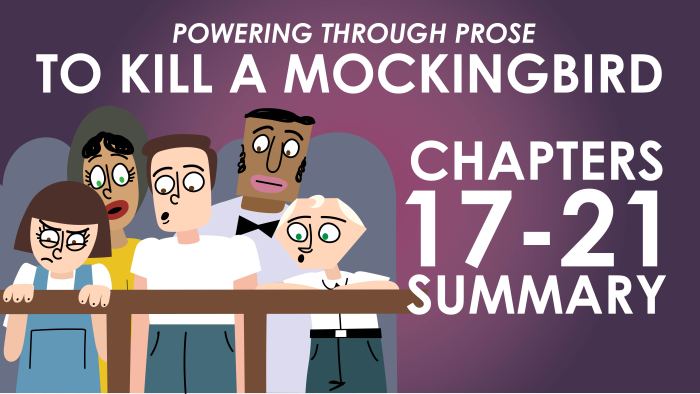To kill a mockingbird ch 22 summary – Embark on an exploration of Harper Lee’s “To Kill a Mockingbird” Chapter 22, where pivotal events, character development, and profound themes intertwine to create a narrative tapestry that illuminates the complexities of human nature and societal prejudices.
As Scout, Jem, and Atticus navigate the tumultuous events of this chapter, their experiences and interactions serve as catalysts for growth, empathy, and a deeper understanding of the world around them.
Chapter 22 Summary
Chapter 22 of “To Kill a Mockingbird” is a pivotal moment in the novel’s narrative. It marks the culmination of the trial against Tom Robinson and the subsequent events that profoundly impact the Finch family and the town of Maycomb.
Key Events: To Kill A Mockingbird Ch 22 Summary

The chapter begins with the jury’s verdict in Tom Robinson’s trial: he is found guilty of raping Mayella Ewell. The verdict shocks the courtroom, including Atticus Finch, who had strongly defended Robinson’s innocence.
The chapter continues with the Finch children, Scout and Jem, witnessing the aftermath of the verdict. They are confronted by the angry and racist mob led by Bob Ewell, who seeks revenge against Atticus for defending Robinson.
Character Development
Scout
In Chapter 22, Scout demonstrates her growing maturity and understanding of the world. She witnesses the injustice of the verdict against Tom Robinson and begins to question the values and beliefs she has been taught.
Jem
Jem’s character also undergoes significant development in Chapter 22. He is deeply affected by the verdict and the subsequent events, which shatter his childhood innocence and force him to confront the harsh realities of life.
Atticus
Atticus Finch remains a steadfast and unwavering figure throughout Chapter 22. Despite the guilty verdict, he continues to believe in justice and the importance of defending those who are innocent.
Symbolism and Themes

Mockingbird
The mockingbird, a symbol of innocence and harmlessness, is frequently referenced throughout Chapter 22. The jury’s decision to convict Tom Robinson is seen as an act of killing a mockingbird, representing the destruction of innocence and justice.
Racism, To kill a mockingbird ch 22 summary
Chapter 22 starkly portrays the deep-rooted racism that permeates Maycomb society. The trial against Tom Robinson is a microcosm of the racial inequality and prejudice that exist in the town.
Narrative Techniques

Foreshadowing
Chapter 22 contains several instances of foreshadowing that hint at the tragic events to come. Bob Ewell’s threats against Atticus and his children foreshadow the danger that awaits them.
Point of View
The chapter is narrated from Scout’s perspective, providing a unique and personal view of the events unfolding in Maycomb. Scout’s childlike innocence and growing understanding of the world shape the reader’s experience.
Social Commentary

Chapter 22 serves as a powerful indictment of the racial injustice and prejudice that existed in the American South during the time period in which the novel is set. It challenges readers to confront the legacy of racism and its impact on society.
Frequently Asked Questions
What is the significance of the trial in Chapter 22?
The trial serves as a microcosm of the racial tensions and prejudices prevalent in the American South during the 1930s.
How does Scout’s perspective evolve in Chapter 22?
Scout’s experiences in the courtroom force her to confront the harsh realities of racial injustice and the hypocrisy of society.
What symbols are employed in Chapter 22?
The mockingbird symbolizes innocence and vulnerability, while the mad dog represents the dangers of prejudice and hatred.